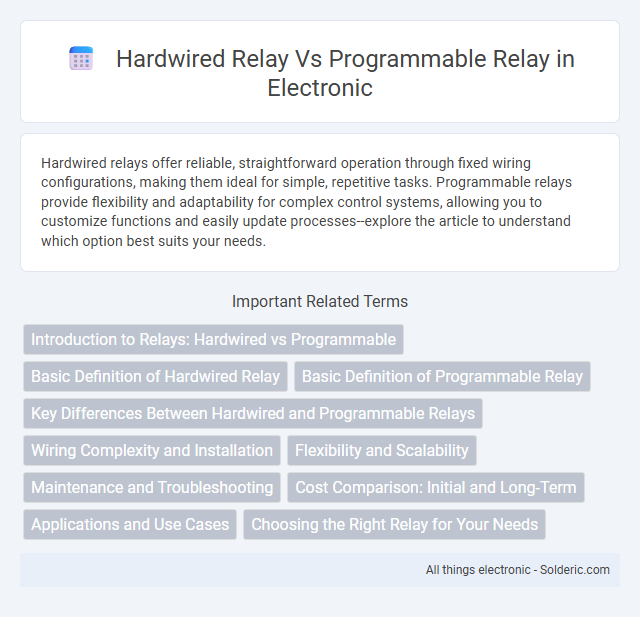Hardwired relays offer reliable, straightforward operation through fixed wiring configurations, making them ideal for simple, repetitive tasks. Programmable relays provide flexibility and adaptability for complex control systems, allowing you to customize functions and easily update processes--explore the article to understand which option best suits your needs.
Comparison Table
| Feature | Hardwired Relay | Programmable Relay |
|---|---|---|
| Definition | Electromechanical switch with fixed wiring. | Software-controlled relay with programmable logic. |
| Flexibility | Low; changes require rewiring. | High; changes via reprogramming. |
| Installation Time | Longer due to manual wiring. | Shorter with software setup. |
| Cost | Lower initial cost. | Higher initial investment. |
| Maintenance | Mechanical wear and tear. | Minimal; mainly software updates. |
| Application | Simple control circuits. | Complex automation tasks. |
| Scalability | Limited scalability. | Highly scalable and modular. |
| Reliability | Mechanical failures common. | High reliability with diagnostics. |
Introduction to Relays: Hardwired vs Programmable
Hardwired relays rely on fixed wiring configurations for specific control tasks, offering reliability and simplicity in industrial automation systems. Programmable relays, also known as programmable logic controllers (PLCs), provide flexible control through software-based programming, allowing for easy modifications and complex logic operations. Understanding the differences between hardwired and programmable relays helps you choose the right solution for efficient and scalable process control.
Basic Definition of Hardwired Relay
A Hardwired Relay is an electromechanical switch designed to control circuits through physically wired connections, enabling direct and reliable operation without the need for programming. In contrast to Programmable Relays, Hardwired Relays operate based on fixed wiring, which limits flexibility but offers simplicity and robustness for straightforward control tasks. Your choice between these relays depends on whether you prioritize adaptability or a durable, easy-to-maintain control system.
Basic Definition of Programmable Relay
A Programmable Relay is a compact industrial control device that uses software to configure and modify logic functions, replacing traditional hardwired relay circuits. Unlike Hardwired Relays, which operate using fixed physical wiring and mechanical switches, Programmable Relays allow You to easily update control sequences without rewiring, improving flexibility and reducing downtime. These devices are ideal for small to medium automation tasks where simple logic control and easy programming are essential.
Key Differences Between Hardwired and Programmable Relays
Hardwired relays rely on fixed electrical wiring to control circuits, offering simplicity and reliability but limited flexibility. Programmable relays use software to manage control logic, providing versatility and easier modifications for complex automation tasks. Your choice depends on whether you require stable, straightforward operation or adaptable, customizable control systems.
Wiring Complexity and Installation
Hardwired relays require extensive wiring and intricate connections, increasing installation time and the potential for errors during setup. Programmable relays simplify wiring complexity by utilizing modular designs and pre-configured input/output modules, enabling faster and more flexible installation. Your choice impacts maintenance ease, with programmable relays offering streamlined updates and modifications without rewiring.
Flexibility and Scalability
Hardwired relays offer limited flexibility and scalability due to their fixed wiring and predefined logic, making modifications labor-intensive and time-consuming. Programmable relays provide greater adaptability by allowing you to easily update control programs and expand system capabilities without rewiring. This flexibility and scalability make programmable relays ideal for evolving industrial applications requiring quick adjustments and future growth.
Maintenance and Troubleshooting
Hardwired relays require more extensive maintenance and troubleshooting due to their physical wiring complexity and limited flexibility, often involving manual inspection and replacement of components. Programmable relays simplify maintenance by allowing software diagnostics and remote monitoring, enabling quicker identification and resolution of faults. Your ability to update or modify control logic in programmable relays reduces downtime compared to the fixed configurations of hardwired relays.
Cost Comparison: Initial and Long-Term
Hardwired relays typically incur lower initial costs due to their simple design and limited functionality but can lead to higher long-term expenses due to inflexibility and costly system modifications. Programmable relays demand higher upfront investment for advanced hardware and software but offer significant savings over time by enabling easy updates, scalability, and reduced downtime. Evaluating specific application needs and scalability requirements is crucial for optimizing total cost of ownership between these two relay types.
Applications and Use Cases
Hardwired relays are commonly used in straightforward, repetitive applications such as motor control, lighting systems, and simple automation processes where fixed logic is sufficient. Programmable relays excel in complex environments requiring flexibility and customization, including multi-step manufacturing processes, building automation, and dynamic control systems. Your choice depends on whether you need rigid, predefined operations or adaptable control with easier updates and scalability.
Choosing the Right Relay for Your Needs
Choosing the right relay depends on your specific application requirements, such as flexibility, complexity, and scalability. Hardwired relays offer reliable, straightforward control with fixed wiring configurations, ideal for simple, repetitive tasks, while programmable relays (PLCs) provide customizable logic functions, making them suitable for more complex automation needs. Your decision should consider factors like ease of modification, cost, and future expansion possibilities to ensure optimal performance and efficiency.
Hardwired Relay vs Programmable Relay Infographic

 solderic.com
solderic.com